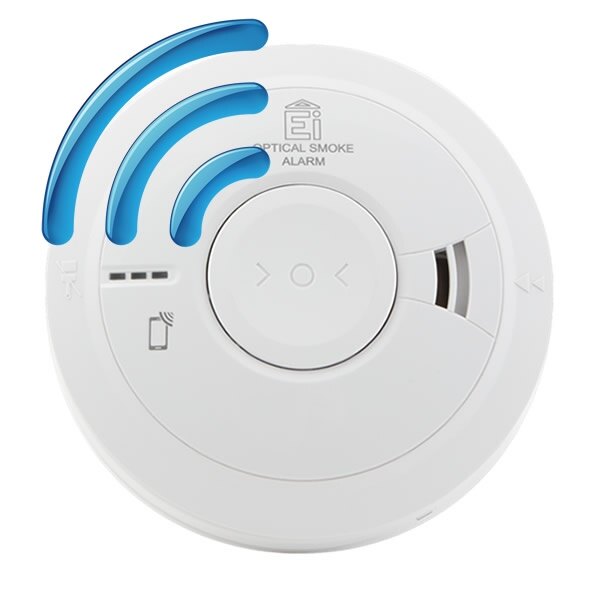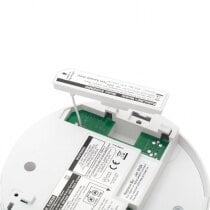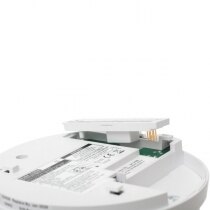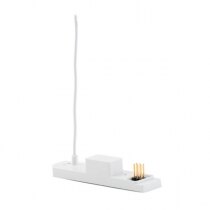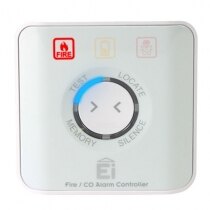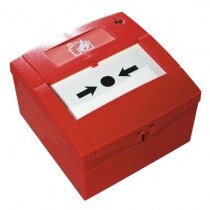-
Contact
Sales & Customer Service
0800 612 6537 support@safelincs.co.uk Live ChatDelivery Enquiries
0800 077 6149 - Resources
Fire & Safety Solutions
CALL OUR TEAM NOW 0800 612 6537
Lines open today 8am - 6pm
Quick Delivery
From £4.19 inc VAT
Live Chat - Online
Instant help & Advice
Trade Discounts
and exclusive pricing
0% Credit Available
Open an account now
5 Star Customer Feedback
Mains Radio-Interlinked Optical Smoke Alarm with Self-Charging 10 Year Back-up Battery - Aico Ei3016RF
Product Overview
Interlink
Technical Data
FAQs (1)
Fitted with a self-charging lifetime back-up battery, the Ei3016RF is a mains powered optical smoke alarm with Ei3000MRF SmartLINK module supplied, meaning that the alarms can be wirelessly interlinked without the need for installing interlinking cables. If cabling is a preference, the Ei3000MRF allows for hybrid interlinking, meaning that up to 12 compatible alarms can be interlinked via a wired or wireless connection. SmartLINK will soon allow for real time notifications of alarm activations to be sent directly via email or text. Fitted with a high performance optical smoke sensor, the Ei3016RF is most suitable for detecting slow, smouldering fires. The Ei3016RF allows you to extract real time data from the alarm directly to your smart phone using the pre-installed AudioLINK technology.
- Power: 230V mains powered with back-up battery
- Backup Battery: Self-charging battery
- Warranty: 5 year warranty
- Each Ei3016RF bundle consists of a Ei3000MRF SmartLINK Module and an Ei3016 Optical Smoke Alarm
- AudioLINK technology allows users to extract real time data to their smart phone or tablet
- High performance optical sensor most suitable for detecting slow, smouldering fires
- Suitable for hallways, landings, living rooms and dining rooms
- Supplied with an Easi-fit baseplate
- SmartLINK allows for new features and hybrid (wired or wireless) interlinking with up to 12 compatible devices
- CE and Kitemarked to BS EN 14604: 2005
- Suitable for installations needed to comply to BS 5839-6: 2019 Grade D1
- Performs its own self-checks every 48 seconds to ensure the alarm is functioning correctly
- Memory feature - easy to identify an alarm that has previously sounded
- Large combined test and silence button
- This alarm is also suitable for both the Welsh and Scottish updated 2022 legislation
The tables below show all the products that can interlink with the Ei3016RF.
Smoke and Heat Alarms - Radio
|
Model Number
|
Type of Unit
|
Type of Interlink
|
| Ei3014 / Ei3014RF | Mains Powered Heat Alarm - Sealed Lithium | Hardwire or Radio Interlink |
| Ei3016 / Ei3016RF | Mains Powered Optical Smoke Alarm - Sealed Lithium | Hardwire or Radio Interlink |
| Ei3024 / Ei3024RF | Mains Powered Optical & Heat Alarm - Sealed Lithium | Hardwire or Radio Interlink |
| Ei3028 / Ei3028RF | Mains Powered Heat & Carbon Monoxide Alarm - Sealed Lithium | Hardwire or Radio Interlink |
| Ei2110e / Ei2110eRF | Mains Powered Multi Sensor Smoke & Heat Alarm - Sealed Lithium | Hardwire or Radio Interlink |
| Ei161e / Ei161eRF | Mains Powered Ionisation Smoke Alarm - Sealed Lithium | Hardwire or Radio Interlink |
| Ei164e / Ei164eRF | Mains Powered Heat Alarm - Sealed Lithium | Hardwire or Radio Interlink |
| Ei166e / Ei166eRF | Mains Powered Optical Smoke Alarm - Sealed Lithium | Hardwire or Radio Interlink |
| Ei141 / Ei168RC141RC | Mains Powered Ionisation Alarm - 9V Alkaline | Hardwire or Radio Interlink |
| Ei144 / Ei168RC144RC | Mains Powered Heat Alarm - 9V Alkaline | Hardwire or Radio Interlink |
| Ei146 / Ei168RC146RC | Mains Powered Optical Smoke Alarm - 9V Alkaline | Hardwire or Radio Interlink |
| Ei3100RF | Battery Powered Ionisation Smoke Alarm - 9V Alkaline | Radio Interlink |
| Ei3103RF | Battery Powered Heat Alarm - 9V Alkaline | Radio Interlink |
| Ei3105RF | Battery Powered Optical Smoke Alarm - 9V Alkaline | Radio Interlink |
| Ei603RF | Battery Powered Heat Alarm - Sealed Lithium | Radio Interlink |
| Ei650RF | Battery Powered Optical Smoke Alarm - Sealed Lithium | Radio Interlink |
Carbon Monoxide Alarms
|
Model Number
|
Type of unit
|
Type of interlink
|
| Ei3018 / Ei3018RF | Mains Powered Carbon Monoxide Alarm - Sealed Lithium | Hardwire or Radio Interlink |
| Ei3028 / Ei3028RF | Mains Powered Heat & Carbon Monoxide Alarm - Sealed Lithium | Hardwire or Radio Interlink |
| Ei262 | Mains Powered Carbon Monoxide Alarm - Sealed Lithium | Hardwire or Radio Interlink |
| Ei261 | Mains Powered Carbon Monoxide Alarm - Sealed Lithium | Hardwire Interlink |
| Ei208WRF | Battery Powered Carbon Monoxide Detector - Sealed Lithium | Radio Iinterlink |
Ancillary Products
|
Model Number
|
Type of unit
|
Type of interlink
|
| Ei170RF | Mains Powered Strobe and Vibration Pad for the Hearing Impaired - Sealed Lithium | Radio Interlink |
| Ei407 | Battery Powered Manual Call Point - Sealed Lithium | Radio Interlink |
| MCP401RC | Mains Powered Manual Call Point | Hardwire Interlink |
| Ei450 | Battery Powered Fire and CO Alarm Controller - Sealed Lithium | Radio Interlink |
| Ei411H | Battery Powered Locate, Silence & Test Control Switch - Sealed Lithium | Radio Interlink |
| Ei410TRF | Battery Powered Test Remote - Sealed Lithium | Radio Interlink (Ei3100RF Series) |
| Ei1529RC | Mains Powered Locate, Silence & Test Control Switch | Hardwire Interlink |
| Ei159 | Mains Powered Smoke Alarm Locator Switch | Hardware Interlink |
| Ei428 | Mains Powered 5A Relay Module | Radio Interlink |
| Ei128R | Mains Powered 5A Relay Module | Hardwire Interlink |
| Ei128RBU | Mains Powered 5A Relay Module with Lithium Backup Battery | Hardwire Interlink |
| Y03 | Mains Powered Multi Frequency Sounder | Hardwire Interlink (via relay) |
| SAB300C | Mains Powered Flashing Xenon Strobe (Clear) | Hardwire Interlink (via relay) |
| SAB300R | Mains Powered Flashing Xenon Strobe (Red) | Hardwire Interlink (via relay) |
Wiring Explained
Mains powered Ei Electronics smoke and heat alarms require a 230V AC power supply and up to 12 alarms can be hardwire interlinked in one system.
To obtain a mains power supply, each alarm can be connected to the nearest lighting circuit using 2 core and earth cable with a separate, dedicated interlink cable connecting alarms where applicable. However, if possible it is recommended that any alarms connected via interlink cable are all powered from a dedicated circuit from the distribution board using 3 core and earth cable for safety during maintenance, as the interlink cable will carry power from live alarms on other power circuits. Please see the diagram below:-
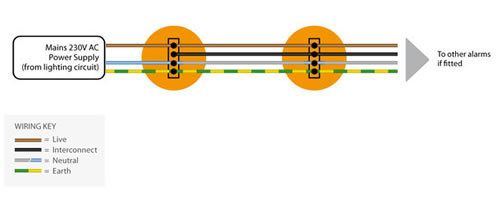
| Product Code | EI3016RF |
|---|---|
| Alternative Product Codes | EI3016, EI3016RF, EI3000MRF |
| Brand | EI Electronics |
| Back-Up Battery | Self-charging Lithium Battery |
| Dimensions (HxDia) | 55 x 150mm |
| Operating Temperature | 0°C to 40°C |
| Relative Humidity | 15% to 95% |
| Sound Output | 85dB |
| Warranty | 5 Years |
| Weight | 0.46kg |
| Product Datasheets |
Q. What sort of smoke alarm system would I need to install for a HMO?
A.
BS 5839-6 recommends that one or two storey HMOs with an individual floor area of no more than 200sqm (not the total of both floors) should have a Grade D smoke alarm system installed. Grade D refers to mains powered smoke alarms with a back up battery power supply. The alarms can be interlinked either by wire or by radio signal and the system does not require a separate fire alarm panel. For HMOs of 3 storey or higher, a Grade A panel system would need to be installed. This can cover the whole of the building, or can be used just for the communal areas with a separate Grade D system installed for the individual dwellings. For both applications, the level of cover should be a minimum of LD3 (in all escape routes) but this may change according to the fire risk assessment.
Pricing & Availability
| Model | Stock | Price |
|---|---|---|
| Product Code: EI3016RF |
Stock Level:
More than 20 in stock Expected dispatch: Today
|
Price:
£112.27 inc VAT £93.56 ex VAT |
Delivery Options
The following delivery options are available on this product.
Customer Reviews
4 customers have given this product an overall rating of 4.8 out of 5
Reviews by real customers
All of our product reviews are written by real customers that have purchased this product from us and are published without modification.Rating: 4 / 5 Stars
Reviewed by: P W
Good bit of kit
Published on: 16th October 2023
Rating: 5 / 5 Stars
Reviewed by: T L
Easy to install and does the job perfectly
Published on: 23rd April 2023
Rating: 5 / 5 Stars
Reviewed by: R Y
Quality product. First class service.
Published on: 3rd July 2022
Looking for more information?
If you have any questions or would like more information about this product you can ask one of our specialists.
Live Chat Available Now
Direct Telephone
01507 464181




















